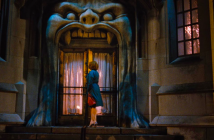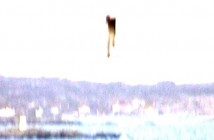The Sky Crawlers (2008)
Cast: Rinko Kikuchi, Ryô Kase, Shôsuke Tanihara
Director: Mamoru Oshii
Country: Japan
Genre: Animation | Adventure | Drama
Official Site: Here
Editor’s Notes: The following review is part of our coverage for TIFF’s Techno/Human: The Films of Mamoru Oshii. For more information on upcoming TIFF film series visit http://tiff.net and follow TIFF on Twitter at @TIFF_NET.
What would the world be like without war between nations? Peaceful and battle free you’d suppose. As much as that seems to be true, it’s become clear that people and society enjoy the excitement and fear that goes with warfare. In a future version of Earth where nations are at ease with each other, the deployment of staged warfare has become commonplace to satisfy society’s need for the thrill.
The Sky Crawlers delves into common themes from Japanese cinema that speak to and about Japanese societies fears.
Director Mamoru Oshii’s The Sky Crawlers (2008) is an outstanding example for a couple of typical anime feature film traits. The depiction of an alternative Earth, futuristic narratives and battles are all intertwined with the anime genre. Mamoru Oshii’s previous features include the iconic Ghost in the Shell (1995) and Patlabor (1989). Patlabor is currently undergoing a reboot by the director and as his reputation tells, he’s some what of an industry favourite. His style is distinctive, like many anime directors, but his animation techniques are fluid and demonstrate an ability to proactively develop rapid movements.
The Sky Crawlers delves into common themes from Japanese cinema that speak to and about Japanese societies fears. A sense of individualism and personal place in an ever changing environment is heightened by the surreal position of the characters we follow. Having never been destined for anything except the thrill of recreating warfare, the young adults known as Kildren are alienated within society. Struggling to come to terms with their reality, once they learn of it, they react with very human responses, bringing into question the ethics of their purpose as entertainment. How this is dealt with is unappreciated for an anime feature. It’s sensitive to the disillusionment of those around the Kildren and unabashed in detailing the Kildren’s discovery of their true selves and therein lack of freedom.
Another common theme that’s uniquely tackled by The Sky Crawlers is the trauma of war and thrill of battle action. As the narrative is fictional it doesn’t have to include the same sort of gravity that hard hitting war dramas like Studio Ghibli’s Grave of the Fireflies (1988). Dealing with children engulfed in war situations is a pressing and difficult matter, but The Sku Crawlers offers a well thought out spin. The fictional narrative allows for a not so weighted representation of growing up through warfare, but that’s not to say that the Kildren here aren’t altered by the exposure to war. The end result of this open narrative slant is the option of an unfixed resolution to the generated battles the Kildren serve to fight in. They suffer in different ways to the children in Grave of the Fireflies of course, but they’re plight is made as passionate a cause. Writing a narrative like this is detrimentally a result of the pressured history of war torn Japan as a back drop.
The Sky Crawlers depicts fighter planes in a more realistic fashion, with an intense amount of fine art attention that’s strikingly close to photo-realism.
As battle sequences are so prevailent in the anime genre, it’s only right that the scenes in The Sky Crawlers hold importance on the genre. Perhaps not as impacting as the style of pop art battle formatting seen in popular TV shows like Pokemon, but the planes in the clouds are unlike represented in any anime films. Recently Hayao Miyazaki’s final feature before retirement The Wind Rises (2013) heavily features planes built for war, but his softer animation style comes across in the very detailed fighter pilots. The Sky Crawlers depicts fighter planes in a more realistic fashion, with an intense amount of fine art attention that’s strikingly close to photo-realism. This coupled with the anime typical facial features of the characters brings together a jarring and progressive outlook to how anime can borderline between looking very imaginary and having the power of fine art realism.
It’s definitely not an easy watching anime that many first time viewers might expect from the genre that grossed in popularity from trading card games like Yu-Gi-Oh! What The Sky Crawlers has to offer is a complex and fascinating narrative and visual style in abundance. A mixture of a surrealist ideal future with a traumatic realism of war, The Sky Crawlers is comparatively an important feature in the body of work of Mamoru Oshii.
What The Sky Crawlers has to offer is a complex and fascinating narrative and visual style in abundance. A mixture of a surrealist ideal future with a traumatic realism of war, The Sky Crawlers is comparatively an important feature in the body of work of Mamoru Oshii.




